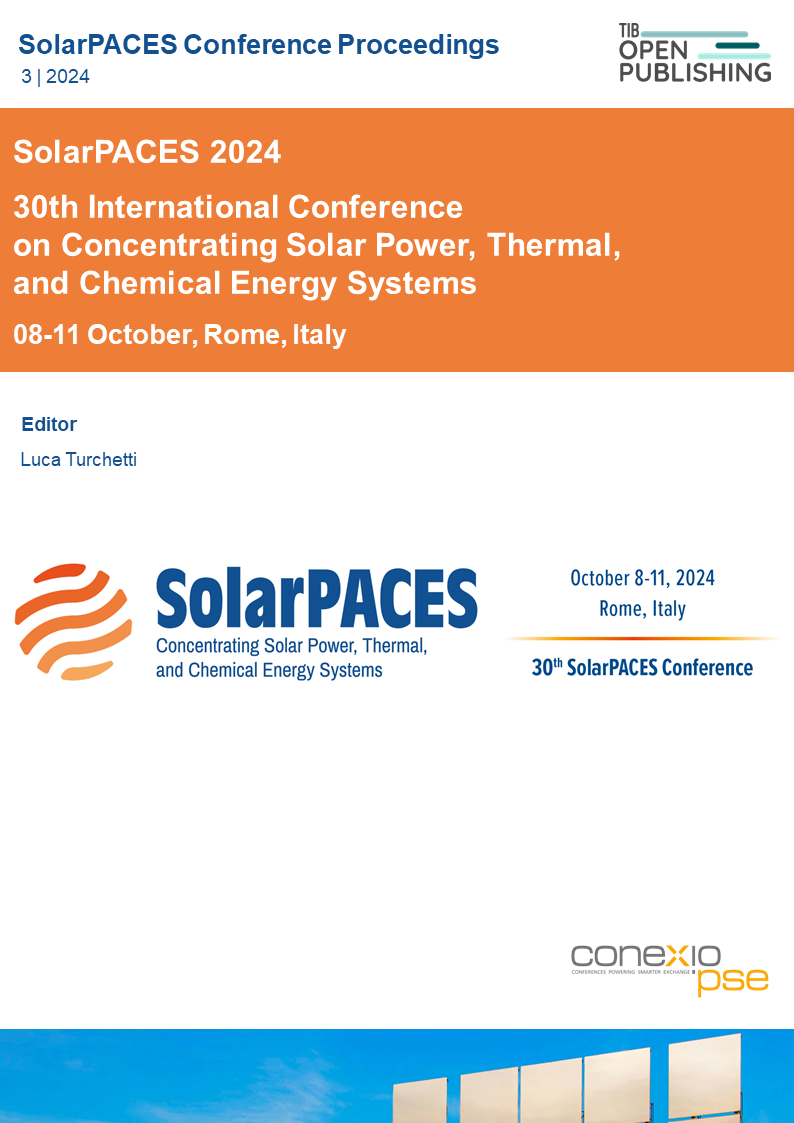Solar-Driven Biomass Pyrolysis Plant for Negative-Emission Biofuels Production
DOI:
https://doi.org/10.52825/solarpaces.v3i.2438Keywords:
Biomass, Solar Pyrolysis, Concentrated Solar Power (CSP), Bio-Oil, BiocharAbstract
As part of the Horizon Europe Project PYSOLO, this study focuses on the integration of a 10 MWTH fast pyrolysis plant with a solar tower system equipped with a rotary kiln particle receiver. Heated particles act as a particle heat carrier (PHC) for the endothermic pyrolysis process, enhancing flexibility and allowing continuous operation compared to directly heated solar reactors. The system’s design, techno-economic analysis and storage capacity optimization are performed considering two operation modes, solar-only and hybrid, in which biochar is combusted in absence of solar energy. Results indicate that, due to the rotary kiln flow regime constraints, its tilt angle has to be limited in a range between 0.5-2° to guarantee particles being in rolling mode, thus penalizing the achievable solar field optical efficiency. On the other hand solar-based pyrolysis can achieve carbon efficiencies close to 0.9 and, thanks to the carbon stored in biochar, net negative emissions equal to -27.05 and -19.45 kgCO2/GJOIL respectively in solar-only and hybrid mode. Moreover, as the pyrolysis section has the most relevant cost share, the system optimization pushes to maximise the pyrolysis plant operating hours (and thus the bio-oil production) to reduce the CAPEX impact on the Minimum Fuel Selling Price (MFSP). For this reason hybrid mode results in being the most convenient (i.e: MFSP of 25.71 vs 21.36 €/GJOIL).
Downloads
References
[1] Renewable Energy Directive (EU) 2023/2413 of the European Parliament and of the Council of 20 November 2023 on the promotion of the use of energy from renewable sources. ELI: https://eur-lex.europa.eu/eli/dir/2023/2413/oj.
[2] R. Adib, “Renewables 2023 global status report collection, Renewables in Energy Sup-ply,” 2023.
[3] A. M. Elgarahy, A. Hammad, D. M. El-Sherif, M. Abouzid, M. S. Gaballah, and K. Z. Elwakeel, “Thermochemical conversion strategies of biomass to biofuels, techno-economic and bibliometric analysis: A conceptual review,” J. Environ. Chem. Eng., vol. 9, pp. 2213–3437, 2021, doi: 10.1016/j.jece.2021.106503.
[4] Venderbosch, R. and Prins, W. (2010), Fast pyrolysis technology development. Biofuels, Bioprod. Bioref., 4: 178-208. https://doi.org/10.1002/bbb.205
[5] CiP Foundation, “How to establish a market for CCS with biochar in Denmark”, 2024,
[6] V. Chintala, Production, upgradation and utilization of solar assisted pyrolysis fuels from biomass – A technical review, Renewable Sustainable Energy Rev., 2018, 90, 120–130, DOI: 10.1016/j.rser.2018.03.066.
[7] S. Jones, et al., Process Design and Economics for the Conversion of Lignocellulosic Biomass to Hydrocarbon Fuels: Fast Pyrolysis and Hydrotreating Bio-Oil Pathway, 2013.
[8] M. Rahman, A. Parvej, M. Aziz, "Concentrating technologies with reactor integration and effect of process variables on solar assisted pyrolysis: A critical review", Thermal Sci-ence and Engineering Progress, Volume 25, 2021, https://doi.org/10.1016/j.tsep.2021.100957.
[9] H. Weldekidan, V. Strezov, G. Town, "Review of solar energy for biofuel extraction", Re-newable and Sustainable Energy Reviews, Volume 88, 2018, Pages 184-192, https://doi.org/10.1016/j.rser.2018.02.027.
[10] PYSOLO – Concentrated solar power for biomass pyrolysis. https://pysolo.eu/ (29/8/24).
[11] M.A. Amjed, F. Sobic, M.C. Romano, T. Faravelli, M. Binotti, “Techno-economic analysis of a solar-driven biomass pyrolysis plant for bio-oil and biochar production”, 2024, Sus-tainable Energy & Fuels, The Royal Society of Chemistry, http://dx.doi.org/10.1039/D4SE00450G.
[12] Aspentech, https://www.aspentech.com/en/products/engineering/aspen-plus, accessed 29/08/24.
[13] A.Gallo et al., “Considerations for using a rotary kiln for high temperature industrial processes with and without thermal storage”, International Solar Energy Society conference proceedings, 2016.
[14] E.Alonso, A.Gallo, M.I.Roldán, C.A.Pérez-Rábago, E.Fuentealba,"Use of rotary kilns for solar thermal applications: Review of developed studies and analysis of their potential", Solar Energy, Volume 144, 2017, Pages 90-104, https://doi.org/10.1016/j.solener.2017.01.004.
[15] B.Bisulandu, F.Huchet, "Rotary kiln process: An overview of physical mechanisms, models and applications", Applied Thermal Engineering, Volume 221, 2023, https://doi.org/10.1016/j.applthermaleng.2022.119637.
[16] C. R. Jones, A. Corona, C. Amador & P. J. Fryer (2021): Dynamics of fabric and dryer sheet motion in domestic clothes dryers, Drying Technology, DOI: 10.1080/07373937.2021.1918706.
[17] A.Boateng, “Rotary Kilns – Transport Phenomena and Transport Process”, 2008, ISBN: 978-0-7506-7877-3.
[18] C.C. Lee, S. Lin (Eds.), Handbook of Environmental Engineering Calculations, McGraw-Hill, New York, 2000.
[19] M. J. Wagner and T. Wendelin, “SolarPILOT: A power tower solar field layout and char-acterization tool,” Sol. Energy, vol. 171, 2018, doi: 10.1016/j.solener.2018.06.063.
[20] T.Wendelin, A.Dobos, A.Lewandowski, “SolTrace: A Ray-Tracing Code for Complex Solar Optical Systems”, 2013, NREL Technical Report.
[21] C. Frantz, R. Buck, and L. Amsbeck, “Design and Cost Study of Improved Scaled-Up Centrifugal Particle Receiver Based on Simulation,” J. Energy Resour. Technol. Trans. ASME, vol. 144, no. 9, 2022, doi: 10.1115/1.4053784.
[22] R. Buck and S. Giuliano, “Impact of CSP design parameters on sCO2-based solar tower plants,” 2nd Eur. Supercrit. CO2 Conf., 2018.
[23] R.Buck, S.Giuliano, “Solar tower system temperature range optimization for reduced LCOE”, AIP Conf. Proc. 2126, 030010 (2019), https://doi.org/10.1063/1.5117522.
[24] Reiner Buck, Jeremy Sment, "Techno-economic analysis of multi-tower solar particle power plants", Solar Energy, Volume 254, 2023, Pages 112-122, https://doi.org/10.1016/j.solener.2023.02.045.
[25] EIA, Monthly Densified Biomass Fuel Report, accessed: 8/9/24, https://www.eia.gov/biofuels/biomass/#table_data.
[26] Q.Kang et al., Particles in a circulation loop for solar energy capture and storage, 2019 Particuology, https://doi.org/10.1016/j.partic.2018.01.009.
[27] L. F. González-Portillo, K. Albrecht, and C. K. Ho, “Techno-economic optimization of CSP plants with free-falling particle receivers,” Entropy, vol. 23, no. 1, 2021, doi: 10.3390/e23010076.
[28] G.Moumin, S.Tescari, C.Sattler,"Impact of bed motion on the wall-to-bed heat transfer for powders in a rotary kiln and effect of built-ins", International Journal of Heat and Mass Transfer, Volume 177, 2021, https://doi.org/10.1016/j.ijheatmasstransfer.2021.121473.
Published
How to Cite
Conference Proceedings Volume
Section
License
Copyright (c) 2025 Muhammad Ahsan Amjed, Marco Colombi, Juan Rincon Duarte, Clarisse Lorreyte, Gkiokchan Moumin, Matteo Carmelo Romano, Marco Binotti

This work is licensed under a Creative Commons Attribution 4.0 International License.
Accepted 2025-04-28
Published 2025-11-18
Funding data
-
European Climate, Infrastructure and Environment Executive Agency
Grant numbers 101118270
